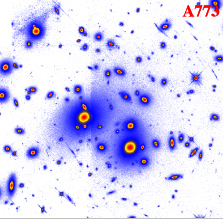
from J.-P. Kneib paper

from J.-P. Kneib paper
What is the total mass distribution of a galaxy cluster? What is its mass distribution profile and how does it compares to the numerical simulation predictions? What is the physical/dynamical state of this cluster? How does the lensing mass estimate compares to X-ray/dynamical/SZ estimates? How massive and how extended are cluster galaxies halos? How massive are filaments between cluster of galaxies? What is the gravitational amplification factor of this lensed galaxy? Any redshift estimates for that multiple images and this arclet? What is the lensing corrected number counts for this galaxy population? and the reconstructed morphology of this lensed galaxy? What are the cosmological constraints that can be derived from cluster lenses observations?
When the cold dark matter particles are allowed to relax to approach an asymptotic thermodynamic equilibrium at the cluster center via, for example, collisions or other forms of relaxation, the cluster center can develop a dense inner core, which has a size much smaller than that of the usual outer core. The cluster mass distribution for such kind of dark matter particles is constructed. Reasonable agreements are found for the predicted lensing mass, galaxy andX-ray gas distributions with the observations.
O. DORE , F.R. BOUCHET and Y. MELLIER .ps .pdf
We describe briefly a new method, allowing to perform a joint and self-consistent perturbative analysis of Sunyaev-Zel'dovich and gravitational weak lensing observations, and to deduce from it an X-ray brightness prediction.
G. GOLSE, J.-P. KNEIB and G. SOUCAIL .ps .pdf
The knowledge of the redshift of multiple images in cluster-lenses allows to determine precisely the total projected mass within the Einstein radius. The observation of various multiple images in a same cluster is opening new possibilities to constrain the curvature of the universe. Indeed, although the influence of Omega_m and Omega_lambda on the images formation is of the second order, observations of many multiple images at different redshifts formed by a regular cluster-lens should allow to constrain very accurately the mass distribution of the cluster and to start to be sensitive to the cosmological parameters entering the diameter angular distances. We present, analytical expressions and numerical simulations that allow us to compute the expected error bars on the cosmological parameters provided an HST/WFPC2 resolution image and spectroscopic redshifts for the multiple images. Numerical tests on simulated data confirm the rather small uncertainties we could obtain this way for the two popular cosmological world models: Omega_m=0.3{pm 0.24}, Omega_lambda=0.7{pm 0.5} or Omega_m=1.{pm 0.33}, Omega_lambda=0.{pm 1.2}. Our method can be applied from now on, on real clusters
T. HAMANA, S. COLOMBI and Y. MELLIER .ps .pdf
We study the cosmic shear statistics using the ray-tracing simulation combined with a set of large $N$-body simulations. We first describe our models and numerical method, and then present some selected results. We especially focus on; (1) effects of the deflection of light rays and the lens-lens coupling on the skewness of the lensing convergence which are neglected in making theoretical predictions of the cosmic shear statistics. (2) effects of the source clustering on a measurement of the skewness of the lensing convergence.
K. UMETSU AND T. FUTAMASE .ps .pdf
We present a weak-lensing analysis of a region around the galaxy cluster Cl 1604+4304 (z=0.897) on the basis of the deep observations ble Space Telescope} ( HST)/Wide Field Planetary Camera 2 (WFPC2). We apply a variant of Schneider's aperture mass technique to the observed WFPC2 field and obtain the distribution of weak-lensing signal-to-noise ratio (S/N) within the field. The resulting S/N map reveals a clear pronounced peak located about 1.'7 (850h_{50}^{-1} kpc at z=0.897) southwest of the second peak associated with the optical cluster center determined from the dynamical analysis of Postman et al. A non-linear finite-field inversion method has been used to reconstruct the projected mass distribution from the observed shear field. The reconstructed mass map shows a super-critical feature at the location of the S/N peak as well as in the cluster central region. Assuming the redshift distribution of field galaxies, we obtain the total mass in the observed field to be 1.0 x 10^{15} h_{50}^{-1}M_0 for < z >=1.0. The estimated mass within a circular aperture of radius 280h_{50}^{-1} kpc centered on the dark clump is 2.4 xes 10^{14}h_{50}^{-1}M_0. We have confirmed the existence of the `dark' mass concentration from another deep HST observation with a slightly different (\sim 20'') pointing.